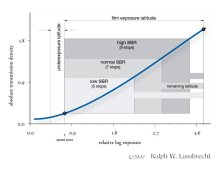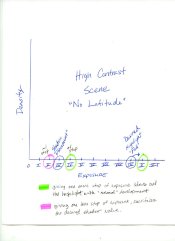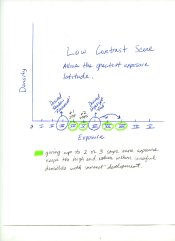............ there is NO latitude towards underexposure only towards overexposure.................
Ralph, my comments below are just my opinion so I'm not saying that it's wrong as I realize I may be missing something from your post, but this is my thinking as it relates to your graph. I have my own simple graphs to illustrate my point, right or wrong.
I believe the discussion of a film's exposure latitude ends when we have to resort to development modification to keep the highend luminance values of the subject to within printable densities on the negative. IMO, at that point, we have exceeded the latitude of the film, that is why we have to modify it's development to maintain printable densities. Your graph indicates that latitude extends to beyond Zone XII (Log E 3.6). IMO, a film's exposure latitude is strictly within the context of how much exposure variation can be given the film (in low contrast subjects) and still keep the high end values easily manageable given normal development.
High contrast scenes do not allow much, if any, exposure latitude. I can make use of my film's latitude with important densities that lie between Zone I and Zone V, because I know that I may also provide exposure from between II to VI; III to VII; IV to VIII, an V to IX for that same subject, provide normal development, and have printable densities through IX (IX being just like I in that it has tonality but no real texture). I may provide plus development in a low contrast scene which is a development modification, but that modification itself has its results still within easily printable high end densities.
As soon as I have to resort to modification in development just to be able to print Zone X densities or higher, latitude is a mute point it seems to me. There has to be a limit to latitude and to me, your graph does not indicate one. You obviously know what you're doing and you have some awesome photographs, perhaps my thinking on film's exposure latitude needs a make over.
Also, why not expose the film properly, make sure it has all the shadow detail, and then print it down as desired? This way, you can have it both ways. It's easy to darken the shadows and hide detail, but it's impossible to get detail out of a blank negative.
Very much agree.
Chuck





